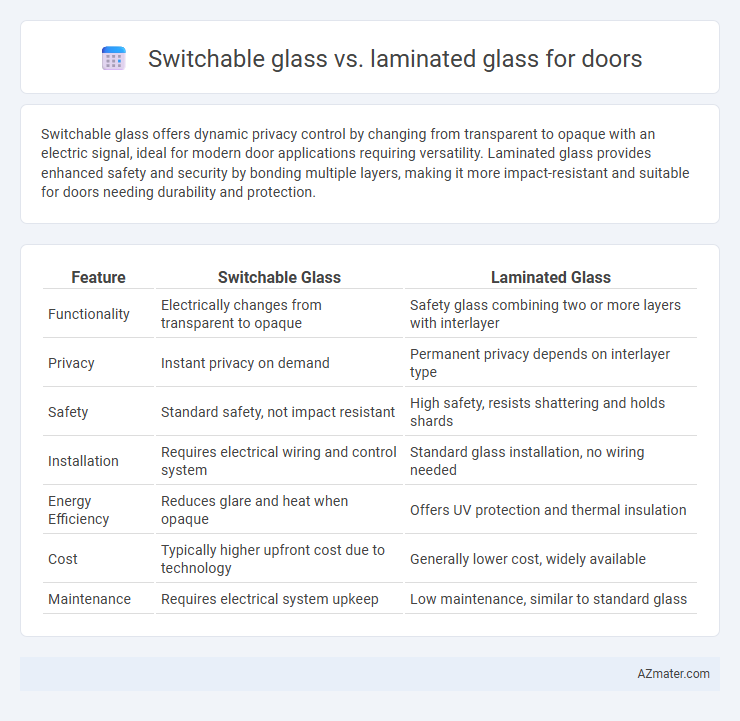Switchable glass offers dynamic privacy control by changing from transparent to opaque with an electric signal, ideal for modern door applications requiring versatility. Laminated glass provides enhanced safety and security by bonding multiple layers, making it more impact-resistant and suitable for doors needing durability and protection.
Table of Comparison
| Feature | Switchable Glass | Laminated Glass |
|---|---|---|
| Functionality | Electrically changes from transparent to opaque | Safety glass combining two or more layers with interlayer |
| Privacy | Instant privacy on demand | Permanent privacy depends on interlayer type |
| Safety | Standard safety, not impact resistant | High safety, resists shattering and holds shards |
| Installation | Requires electrical wiring and control system | Standard glass installation, no wiring needed |
| Energy Efficiency | Reduces glare and heat when opaque | Offers UV protection and thermal insulation |
| Cost | Typically higher upfront cost due to technology | Generally lower cost, widely available |
| Maintenance | Requires electrical system upkeep | Low maintenance, similar to standard glass |
Introduction to Switchable and Laminated Glass for Doors
Switchable glass, also known as smart glass, uses electrochromic or liquid crystal technology to change from transparent to opaque on demand, offering privacy and energy efficiency for doors. Laminated glass consists of two or more layers of glass bonded with an interlayer, providing enhanced safety, sound insulation, and UV protection. Both types are popular in modern door applications, with switchable glass emphasizing dynamic privacy control and laminated glass focusing on security and durability.
How Switchable Glass Works in Door Applications
Switchable glass in door applications utilizes liquid crystal technology embedded between glass layers that changes from opaque to transparent when electrical voltage is applied, allowing instant control of privacy and light transmission. This glass relies on an electric current to align liquid crystals, enabling doors to switch between frosted and clear states without mechanical blinds or curtains. Unlike laminated glass, which offers structural safety and impact resistance through interlayer bonding but remains constantly transparent, switchable glass provides dynamic privacy solutions ideal for modern, flexible interior and exterior door designs.
Key Features of Laminated Glass Doors
Laminated glass doors consist of two or more glass layers bonded with a durable interlayer, enhancing safety and security by preventing shattering upon impact. This type of glass offers excellent sound insulation and UV protection, making it ideal for external door applications. Its strength and resistance to forced entry surpass switchable glass, which primarily focuses on privacy control through light modulation.
Comparative Safety and Security Benefits
Switchable glass enhances security by instantly changing from transparent to opaque, ensuring privacy while deterring potential intruders. Laminated glass offers superior impact resistance, holding shards together upon breakage to prevent injuries and unauthorized entry. Both types improve door safety, with switchable glass providing dynamic privacy control and laminated glass delivering robust physical protection.
Privacy Control: Switchable vs Laminated Glass
Switchable glass offers dynamic privacy control by instantly changing from transparent to opaque with an electrical switch, making it ideal for adaptable door applications. Laminated glass provides static privacy through layers of glass and interlayers that obscure visibility but cannot change opacity. Switchable glass enables on-demand privacy without compromising natural light, while laminated glass ensures continuous, fixed privacy and enhanced safety.
Energy Efficiency and Insulation Performance
Switchable glass offers dynamic control over light transmission and heat gain, significantly reducing cooling costs by blocking solar heat when tinted. Laminated glass provides superior sound insulation and enhanced thermal resistance due to its interlayer, improving overall energy efficiency by minimizing heat loss. Both options enhance door insulation, but switchable glass optimizes energy management through adjustable transparency, while laminated glass excels in consistent thermal insulation and safety.
Design and Aesthetic Flexibility
Switchable glass offers dynamic transparency control, allowing users to transform doors from clear to opaque for privacy without sacrificing natural light, enhancing design adaptability. Laminated glass provides a sleek, smooth surface with options for embedded textures, colors, or patterns, contributing to a static but customizable aesthetic appeal. Both materials support modern architectural styles, but switchable glass delivers superior versatility in visual customization and spatial ambiance.
Installation and Maintenance Considerations
Switchable glass for doors requires complex electrical wiring and specialized installation to integrate the smart technology, often involving professional expertise to ensure proper functionality and safety compliance. Laminated glass installation is more straightforward, focusing on secure framing and sealing to maintain its safety and soundproofing features, with fewer technical requirements. Maintenance for switchable glass involves periodic checks of electrical components and control systems, whereas laminated glass primarily needs regular cleaning and inspection for any delamination or edge damage.
Cost Factors and Long-Term Value
Switchable glass typically has higher upfront costs than laminated glass due to advanced technology and installation complexity, but it offers energy savings and privacy control that can reduce long-term expenses. Laminated glass is more affordable initially, provides strong safety benefits by holding shards together when broken, and requires less maintenance, contributing to long-term value. Evaluating cost factors against durability, energy efficiency, and functionality helps determine the best choice for door applications.
Choosing the Best Glass Solution for Your Door
Switchable glass offers privacy on demand with its electrochromic technology, making it ideal for doors needing adjustable translucency and modern aesthetics. Laminated glass provides enhanced safety and sound insulation due to its multiple bonded layers, suitable for entry doors requiring durability and security. Selecting the best glass solution depends on prioritizing privacy features, safety standards, and energy efficiency specific to your door application.

Infographic: Switchable glass vs Laminated glass for Door
 azmater.com
azmater.com